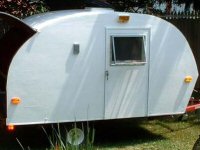Insulated or not?
27 posts
• Page 1 of 2 • 1, 2
Insulated or not?
Hello everybody,
I'm getting real close to starting work on my teardrop and I'm suddenly hit with a new thought. Up till now, I'd pretty much assumed that the only choice was to build framed walls with insulation. Now I've been given the suggestion that the walls could be made more simply with 3/4" plywood, no framing, and no insulation. I've also seen statements from people who have built this way who say that their trailers are very comfortable even in cold weather. Part of the reason I wanted to insulate the sides is so I can take it to Vermont in October.
So, my previous thought was to use 1" poplar framing with 1/4" plywood outside and 1/8" inside, and 1" foam insulation in the gaps. (I've seen some designs using 1/2" plywood, but I was going to take my chances with 1/4".) How would my idea compare in weight, cost, and strenth to the alternative -- just using 3/4" plywood unframed and uninsulated?
As a thought experiment, I hit on the idea of using 3/4" plywood in place of the framing (is that called "spars"?) and then cutting out holes in the board big enough for the insulation. (I've seen that described on this message board.) I figured I'd need to cut away roughly 2/3's of the area of the inner board to keep the weight the same. It seems to me, then, that (provided the glue is strong) the thicker wall would be stronger and lighter. Am I on the right track here?
I'm getting real close to starting work on my teardrop and I'm suddenly hit with a new thought. Up till now, I'd pretty much assumed that the only choice was to build framed walls with insulation. Now I've been given the suggestion that the walls could be made more simply with 3/4" plywood, no framing, and no insulation. I've also seen statements from people who have built this way who say that their trailers are very comfortable even in cold weather. Part of the reason I wanted to insulate the sides is so I can take it to Vermont in October.
So, my previous thought was to use 1" poplar framing with 1/4" plywood outside and 1/8" inside, and 1" foam insulation in the gaps. (I've seen some designs using 1/2" plywood, but I was going to take my chances with 1/4".) How would my idea compare in weight, cost, and strenth to the alternative -- just using 3/4" plywood unframed and uninsulated?
As a thought experiment, I hit on the idea of using 3/4" plywood in place of the framing (is that called "spars"?) and then cutting out holes in the board big enough for the insulation. (I've seen that described on this message board.) I figured I'd need to cut away roughly 2/3's of the area of the inner board to keep the weight the same. It seems to me, then, that (provided the glue is strong) the thicker wall would be stronger and lighter. Am I on the right track here?
-

Salivanto - Teardrop Advisor
- Posts: 95
- Images: 7
- Joined: Fri May 06, 2005 9:37 am
- Location: Rochester, NY
Re: Insulated or not?
Salivanto wrote:Hello everybody,
I'm getting real close to starting work on my teardrop and I'm suddenly hit with a new thought. Up till now, I'd pretty much assumed that the only choice was to build framed walls with insulation. Now I've been given the suggestion that the walls could be made more simply with 3/4" plywood, no framing, and no insulation. I've also seen statements from people who have built this way who say that their trailers are very comfortable even in cold weather. Part of the reason I wanted to insulate the sides is so I can take it to Vermont in October.
So, my previous thought was to use 1" poplar framing with 1/4" plywood outside and 1/8" inside, and 1" foam insulation in the gaps. (I've seen some designs using 1/2" plywood, but I was going to take my chances with 1/4".) How would my idea compare in weight, cost, and strenth to the alternative -- just using 3/4" plywood unframed and uninsulated?
As a thought experiment, I hit on the idea of using 3/4" plywood in place of the framing (is that called "spars"?) and then cutting out holes in the board big enough for the insulation. (I've seen that described on this message board.) I figured I'd need to cut away roughly 2/3's of the area of the inner board to keep the weight the same. It seems to me, then, that (provided the glue is strong) the thicker wall would be stronger and lighter. Am I on the right track here?
Hi, Sali.
I think 1/4 sides are pretty thin, even with framing. Even the Cubby, which is tiny, uses 3/8.
If you went 3/4 without framing, what do you envision as the advantage? Less cost and less work? People do it this way, but if you want to get out there in the winter, in VERMONT, I would think you want to do the thinner wall, with the framing and insulation. The framing and insulation is not going to be a big deal, and it will give you more options to run wires. Granted, you're going to have to skin the inside with thin material, but this will give you a bunch of decorating options--your choice of paneling, to stain, etc.
I'm pretty new to this myself, and I've learned there are a lot of "right" ways to do it. A 3/4 wall with no framing or insulation isone of them, but think if that's what you really want for your climate.
As far as taking a sheet of ply, cutting out huge holes for insulation, and using that instead of stick framing...why???
(And FYI: spars are the pieces that connect the side walls. The framing on the walls is just called framing.)
--Ira
"My HD and Wal-Mart have been out of Titebond for weeks, and I think it's a communist conspiracy."
"My HD and Wal-Mart have been out of Titebond for weeks, and I think it's a communist conspiracy."
-

IraRat - Forum Storyteller
- Posts: 1573
- Joined: Wed Apr 06, 2005 8:43 am
- Location: South Florida


 )
)





